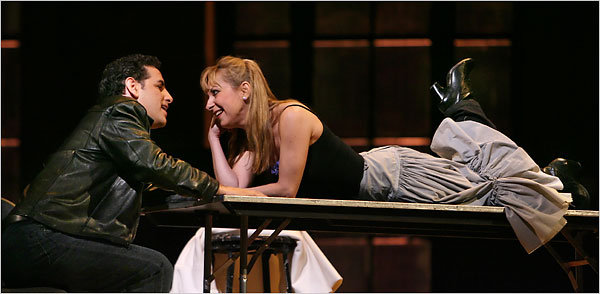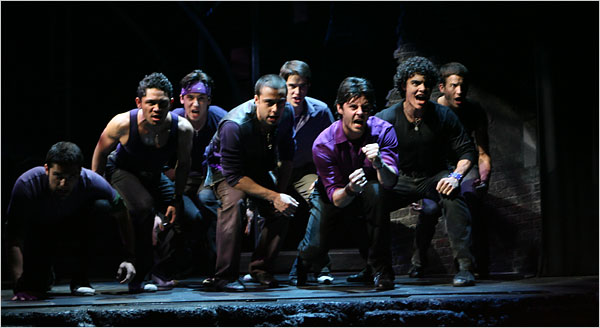“The theater is so endlessly fascinating because it’s so accidental. It’s so much like life.”
Arthur Miller (quoted in the New York Times, May 9, 1984)
Archives for March 2009
WHY NOT BOO?
“Since many theater companies now encourage playgoers to recycle their programs, why not place two transparent recycling containers in the lobby after the show, one marked CHEERS and the other JEERS? That strikes me as a neat and practical method of reaping the benefits of booing while simultaneously minimizing its incivility…”
TT: Why not boo?
 Mary Zimmerman’s new production of Bellini’s La Sonnambula got booed–loudly–when it opened at the Met the other day. (To hear what happened, go here.) I didn’t see the production, but I was struck by the fact that such booing is surprisingly rare in this country, whereas automatic standing ovations for mediocre performances are very much the rule, at least on Broadway.
Mary Zimmerman’s new production of Bellini’s La Sonnambula got booed–loudly–when it opened at the Met the other day. (To hear what happened, go here.) I didn’t see the production, but I was struck by the fact that such booing is surprisingly rare in this country, whereas automatic standing ovations for mediocre performances are very much the rule, at least on Broadway.
I’m not crazy about booing, but there’s one thing to be said in its favor. And what, pray tell, might that one thing be? Pick up a copy of Saturday’s Wall Street Journal and turn to my “Sightings” column to find out the answer. This week’s column also features a modest proposal for a method of allowing unhappy audiences to register their disapproval of a performance without throwing tomatoes. Producers, take note!
UPDATE: Here’s an excerpt:
Is there a kinder, gentler way for an audience to make its displeasure felt? After reflecting on Ms. Zimmerman’s tumultuous curtain call, I came up with a substitute that I call “The Silent Boo.” Since many theater companies now encourage playgoers to recycle their programs, why not place two transparent recycling containers in the lobby after the show, one marked CHEERS and the other JEERS? That strikes me as a neat and practical method of reaping the benefits of booing while simultaneously minimizing its incivility. Wouldn’t your emotional investment in a performance be heightened if you could “vote” on its merits in a simple and convenient manner that was easily visible both to the performers and to your fellow audience members?…
Read the whole thing here.
TT: Tough guys don’t dance
I review three shows in today’s Wall Street Journal drama column, the new Broadway versions of West Side Story and Blithe Spirit and a Rhode Island revival, 2nd Story Theatre’s production of William Inge’s The Dark at the Top of the Stairs. The first two are so-so, the third a treat. Here’s an excerpt.
* * *
Having staged an all-but-unimprovable revival of “Gypsy,” Arthur Laurents has upped the ante by bringing “West Side Story” back to Broadway. Mr. Laurents’ “West Side Story” is a spruced-up version of the show that took New York by storm 52 years ago, revised and reconfigured to appeal to a new generation of theatergoers. Nothing wrong with that–“West Side Story” is a musical, not a sacred text–but the results are disappointing, not just by comparison with the original “West Side Story” but in their own unconvincing right.
 The most talked-about change is that the 91-year-old Mr. Laurents, who wrote the book, has made the Sharks, the Manhattan street gang whose members come from Puerto Rico, speak and sing partly in Spanish. The purpose of this new wrinkle is to add dramatic muscle to a musical that he now believes to be too ballet-pretty for modern audiences. For the same reason, Joey McKneely, who restaged Jerome Robbins’ dances for this production, has altered them in ways that will be immediately apparent to anyone who knows “West Side Story” more than casually….
The most talked-about change is that the 91-year-old Mr. Laurents, who wrote the book, has made the Sharks, the Manhattan street gang whose members come from Puerto Rico, speak and sing partly in Spanish. The purpose of this new wrinkle is to add dramatic muscle to a musical that he now believes to be too ballet-pretty for modern audiences. For the same reason, Joey McKneely, who restaged Jerome Robbins’ dances for this production, has altered them in ways that will be immediately apparent to anyone who knows “West Side Story” more than casually….
The show’s bilingual aspect comes across as a gimmick, one that works well in some spots and less so in others. The second act, for instance, starts out with a long, bumpy stretch of untranslated Spanish that feels like an opera without supertitles. The changes in the dances are far more fundamental and problematic. The steps remain familiar, but the feel is entirely different–the men dance as though they were on steroids–and almost entirely untrue to the spirit of the original show. According to Mr. Laurents, the real-life counterparts of the Jets and Sharks were “vicious little killers” whose brutality was softened in the 1957 production. But that, of course, is the whole point of “West Side Story”: It’s not a cinéma-vérité documentary but a poem, a piece of lyric theater. The hyper-masculine faux-realism that Mr. Laurents has ladled over it simply doesn’t square with the idealized romanticism of Robbins’ choreography and Leonard Bernstein’s jazzy score…
Few modern farces are as bulletproof as Noël Coward’s “Blithe Spirit,” which doesn’t have to be done especially well to make a willing audience laugh. Michael Blakemore’s revival is better than good enough, but its virtues are mainly to be found in the indispensable persons of Angela Lansbury and Rupert Everett. Ms. Lansbury, needless to say, is Madame Arcati, the dotty medium who inadvertently summons up the ghost of Mr. Everett’s first wife (Christine Ebersole), much to the displeasure of his second wife (Jayne Atkinson)….
I wish I had more good things to say, but Ms. Ebersole proves to be both unexpectedly unseductive and unsatisfyingly shrill, while Mr. Blakemore’s staging, a couple of slick bits of slapstick notwithstanding, is efficient rather than inspired….
William Inge was a great American playwright whose work is rarely done in New York nowadays, so I drove up to Rhode Island to catch a revival of “The Dark at the Top of the Stairs,” a family drama that hasn’t been seen on Broadway since the original production closed in 1959. I’m happy to report that 2nd Story Theatre, an ambitious little troupe whose 130-seat upstairs auditorium is located in a harbor town not far from Providence, is performing “The Dark at the Top of the Stairs” with exceptional sensitivity and understanding….
* * *
Read the whole thing here.
This is my video review of West Side Story:
TT: Almanac
“Jealousy is often the tribute artists pay one another.”
Harold Clurman, All People Are Famous (Instead of an Autobiography)
TT: So you want to see a show?
Here’s my list of recommended Broadway, off-Broadway, and out-of-town shows, updated weekly. In all cases, I gave these shows favorable reviews (if sometimes qualifiedly so) in The Wall Street Journal when they opened. For more information, click on the title.
Warning: Broadway shows marked with an asterisk were sold out, or nearly so, last week.
BROADWAY:
• Alfred Hitchcock’s The 39 Steps * (comedy, G, suitable for bright children, reviewed here)
• August: Osage County (drama, R, adult subject matter, reviewed here)
• Avenue Q * (musical, R, adult subject matter and one show-stopping scene of puppet-on-puppet sex, reviewed here)
• The Little Mermaid * (musical, G, entirely suitable for children, reviewed here)
• South Pacific * (musical, G/PG-13, some sexual content, brilliantly staged but unsuitable for viewers acutely allergic to preachiness, reviewed here)
OFF BROADWAY:
• Distracted (serious comedy, PG-13, extended through May 17, reviewed here)
• The Fantasticks (musical, G, suitable for children capable of enjoying a love story, reviewed here)
• Love/Stories (or But You Will Get Used to It) (one-act plays, PG-13, vastly too complicated for children, newly extended through Apr. 25, reviewed here)
• Our Town (drama, G, suitable for mature children, reviewed here)
• Ruined (drama, PG-13/R, sexual content and suggestions of extreme violence, extended through May 3, reviewed here)
CLOSING NEXT WEEK OFF BROADWAY:
• Aristocrats (drama, G/PG-13, too complicated for children, closes Mar. 29, reviewed here)
CLOSING FRIDAY OFF BROADWAY:
• Enter Laughing (musical, PG-13, closes Mar. 20, reviewed here)
TT: Almanac
“Today every invention is received with a cry of triumph, which soon turns into a cry of fear.”
Bertolt Brecht (quoted in Harold Clurman, All People Are Famous)
TT: The house that Satchmo built
 My friend and colleague Ricky Riccardi, who blogs to indispensable effect about the life and work of Louis Armstrong, recently posted a photograph of Armstrong’s house in Queens that was taken in 1965. The Armstrong house, which is now a museum, looks slightly more imposing today–but not much.
My friend and colleague Ricky Riccardi, who blogs to indispensable effect about the life and work of Louis Armstrong, recently posted a photograph of Armstrong’s house in Queens that was taken in 1965. The Armstrong house, which is now a museum, looks slightly more imposing today–but not much.
I first visited the Armstrong House in 2001, a number of years before I first got the idea to write Pops: A Life of Louis Armstrong. I was writing a piece about Armstrong for the Sunday New York Times–the occasion was his hundredth birthday–and though his house was not yet open to the public, I was given a private tour. That tour was part of what inspired me to become Armstrong’s biographer, and the passage from my Times article in which I described the interior made it all the way into Pops with only the slightest of changes:
It is a three-story frame house whose interior is reminiscent of Graceland, Elvis Presley’s gaudy Memphis mansion. From the Jetsons-style kitchen-of-the-future to the silver wallpaper and golden faucets of the master bathroom, the Armstrong house looks like what it is: the residence of a poor boy who cast down his bucket and pulled it up overflowing. Unlike Graceland, though, the house is neither oppressive nor embarrassing, and as you stand in the smallish study, whose decorations include a portrait of the artist painted by Tony Bennett, it is impossible not to be touched by the aspiration visible wherever you look. This, it is clear, was the home of a working man, bursting with a pride that came not from what he had but what he did. “I never want to be anything more than I am, what I don’t have I don’t need,” Armstrong wrote in his old age. “My home with Lucille [his fourth and last wife] is good, but you don’t see me in no big estates and yachts, that ain’t gonna play your horn for you.”
If you’ve never been to the Armstrong House, I strongly suggest a visit. For more information, go here.
